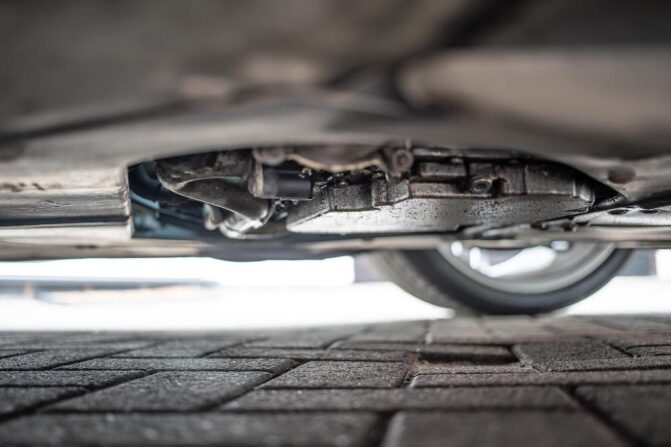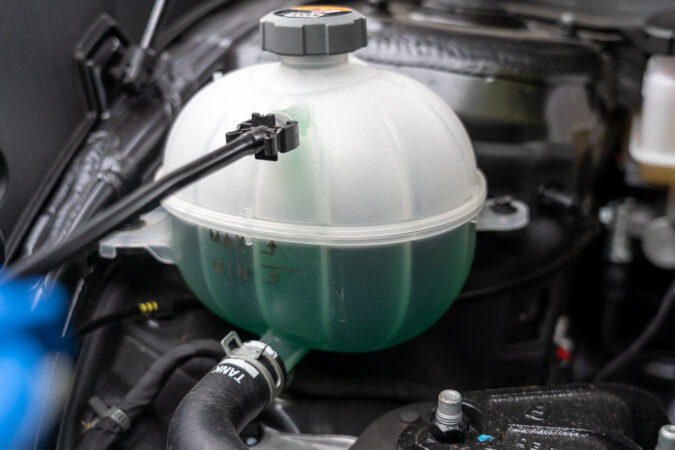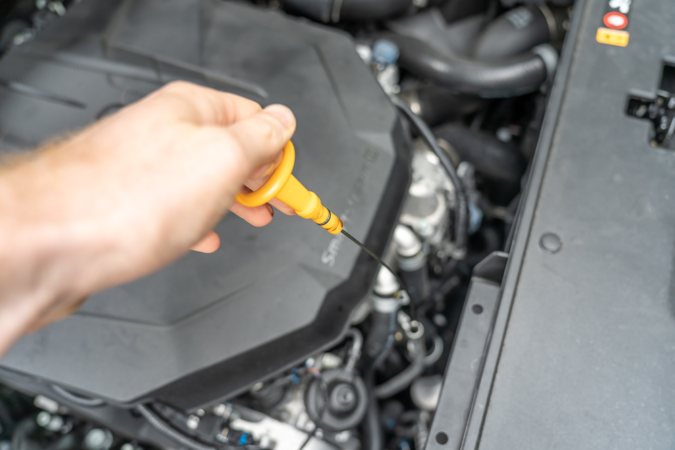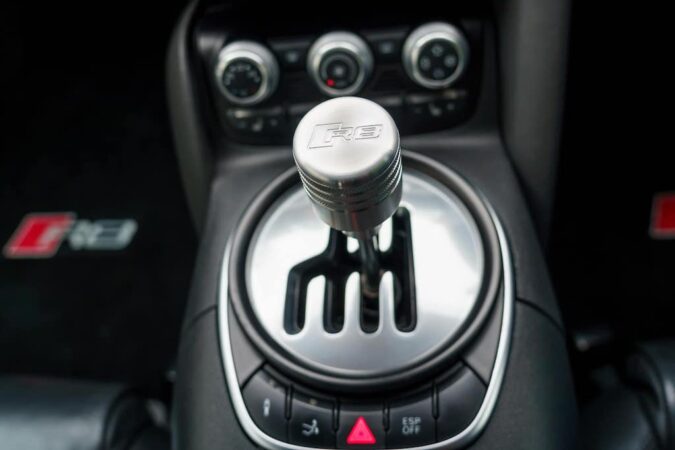Have you looked under your car only to see a small puddle of reddish fluid? This is likely the result of a transmission seal leak. This leak is usually continuous and causes a train of fluid across your garage floor.
If your car is leaking transmission fluid, then this can cause major issues that can result in you spending a lot of cash on repairs.
Keep reading to learn more about the causes of transmission fluid leaks, the cost of repair, and how to fix the problem at home.
You can use our table of contents below to navigate easily throughout the post.
- Front Transmission Seal Leak
- Rear Transmission Seal Leak
- Seal Leak Repair Cost
- Seal Leak Symptoms
- Transmission Stop Leak
- Leak When Parked
- Leak Only When Running
- Leaking From Front Of Car
- Transmission Fluid Leak Color
- Driving On Low Transmission Fluid
- Frequently Asked Questions
Front Transmission Seal Leak
The role of the front transmission seal is to prevent any fluid leaks through the space where the transmission case connects to the torque converter. The front seal is often made from a rubber material.
Several reasons could result in a front transmission leak. One of the major reasons is damage to the transmission seal.
If you drive an automatic transmission vehicle, then the transmission will create pressure via the transmission seals. Over time, the pressure may cause damage to the transmission seals causing them to crack or wear out.
This is especially the case if there is a lot of transmission fluid resulting or if they are exposed to heat for long periods.
Rear Transmission Seal Leak
One of the major causes of a rear transmission seal leak is damage to the rear seal itself. This can occur due to exposure to heat or the pressure over time caused by the hydraulic forces.
You can locate the rear transmission seal leak at the back of your vehicle’s engine. The role of the rear transmission seal is to seal off the crankshaft where it comes out of the engine and connects to the transmission.
The role of the rear transmission seal is to prevent leaking from the crankshaft back end. It is important to ensure that the rear transmission seal leak is in good condition as fixing it can prove an expensive and time-consuming process.
This is because to fix the rear transmission seal leak, you need to dismantle the engine and the transmission.
Transmission Front Seal Leak Repair Cost
Just like how moving engine parts require oil for lubrication and to ensure everything is running smoothly so does the transmission. After all, the transmission also involves many moving parts.
The transmission fluid is responsible for ensuring the moving parts of the transmissions do so fluidly and smoothly. The fluid is in turn locked in and prevented from leaking out by transmission seals.
The front transmission seal is among the most important seals in the setup.
Though the costs will depend on your vehicle model, on average it will cost you around $300 to fix a leaking front transmission seal. Often vehicle owners pay between $150, on the low end, to $600.
The front transmission seals are costlier than the rear ones as there is a lot more work involved in the replacement process. The mechanic will need to disassemble the engine and transmission to be able to access it.
Transmission Front Seal Leak Symptoms
There are a couple of signs and symptoms that tell you the transmission front seal is leaking. Inspecting your transmission for any signs of damaged seals and fixing the problem early can save you thousands of dollars in repair costs in the future.
1. Dipstick Reading
The first symptom that could alert you to a potential transmission front seal leak is when you check the dipstick to see the level of the transmission fluid.
To get a proper and reliable reading, simply remove the dipstick, wipe it clean and then reinsert it and then check the transmission fluid level.
If the amount is low then this is a clear sign of a leaking front transmission seal.
The color of the transmission fluid should be pinkish and almost clear. If you notice that the color is brownish then it should be drained out and replaced with new fluid.
2. Dashboard Light
Modern car dashboards have all kinds of warning lights. Their role is to let you know about possible engine issues. The transmission light could alert you to several transmission issues such as overheating due to excess transmission fluid.
It could also be telling you of a possible leak in the transmission fluid. Either way, taking your car to a mechanic to help diagnose the problem is a good idea.
3. Visible Fluid Leaks
The simplest way to tell if you have a transmission fluid leak is to look underneath your car. If you see a puddle of pinkish fluid then it is likely that you have a transmission front seal leak.
You may also notice spots where you previously parked your car. A quick solution to this problem is to apply a transmission stop leak. This causes the front seal to swell and fill up on the spaces that allow the transmission fluid to leak.
4. Grinding Noise
If you have a transmission front seal leak, you may begin to notice grinding noises coming from the transmission area. This is a sign that the transmission fluid is low and that the synchronizer has sustained damage as a result.
Whenever you hear noises that just don’t sound right it is a good idea to take your vehicle to a mechanic for a proper diagnosis. Noises coming from the transmission are never a good sign so it’s crucial that you take the car to the mechanic quickly.
5. Clunking Sounds
Another type of sound that could show an issue with the transmission is a clunking sound.
If you notice this sound, quickly take your vehicle to a repair shop and have a mechanic look at it before it results in more serious damage.
6. Slowed Acceleration
The role of the transmission is to change gears within an instant. When the transmission fluid is at an optimum level, it provides good lubrication allowing the gears to change fluidly without you noticing.
If the front seal is leaking transmission fluid resulting in a lack of enough fluid, this will cause a delayed response when changing gears. The car, therefore, fails to accelerate smoothly.
In this case, you will notice that your vehicle is able to achieve a high RPM when you step on the gas but doesn’t accelerate fast but instead moves sluggishly.
You may also notice that the engine will rev but the vehicle doesn’t accelerate.
7. Temperature Light On The Dashboard
A leaking front transmission seal will mean that the transmission will not have sufficient amounts of lubrication. As a result, the moving parts will grind against each other causing friction and heat. A front transmission seal leak therefore cannot be ignored as it can cause a cascading effect to other parts of your car.
If you notice that the heat is radiating from below the car in the area of the transmission and the engine temperature light on the dashboard has turned on, then this could be a sign of a faulty front transmission seal.
Transmission Stop Leak
Whenever drivers notice transmission leaks, their first go-to solution is a transmission stop leak.
The product works by sealing off the leaks in the transmission. However, it is important to note that they are by no means a long-term solution and they do not replace getting new transmission fluid seals.
The transmission system mostly relies on hydraulic pressure to change gears. When there is too much transmission fluid, there may be excessive pressures exerted on the transmission fluid seals causing them to damage.
This can result in leaks. Wear and tear can also cause transmission fluid seals to be damaged.
This is where a transmission stop leak could come in handy.
Transmission Stop Leak – How It Works
The transmission stop leaks work in an interesting manner. When applied to the transmission seals, the additives in the stop leak causes the seals to swell which closes up any holes through which the transmission fluid is leaking.
The transmission stop leak will work for any type of transmission whether it’s an automatic transmission or a manual transmission.
Transmission Stop Leak – Is It Safe To Use?
It is not advisable to use a transmission stop leak for a long period of time. This is because while they offer a fast solution, they are no substitute for replacing worn-out transmission seals.
Also, it is important to keep in mind that the stretching of the transmission seals after a stop leak application could result in further wear and tear.
The stop leak does not identify parts of the seal that are damaged against those parts in good condition. This, therefore, means that the parts that are in good condition that swell could end up causing even more damage to the seals.
Transmission Stop Leak – How Long Does It Take To Work?
How quickly the transmission stop leak takes to work will depend on the brand. On average, it takes 2 to 3 days to seal the leaks.
Some brands will advise that you wait for 30 minutes for the transmission stop leak to blend well with the seal.
Transmission Fluid Leak When Parked
You may have parked your vehicle for a while only to move it and notice pinking or brownish fluid on the ground. You may also see this fluid when you look under your car.
It is likely the transmission fluid is leaking. Several reasons could cause transmission fluid leaks when parked.
1. Damaged Seals
As we have emphasized in this post, the main reason behind a transmission seal leak is damaged seals. This can occur due to several reasons such as wear and tear over time.
Another reason could be too much transmission fluid in the transmission which causes overheating and excessive pressure on the seals.
But damaged seals are not the only cause of transmission fluid leaks when parked.
2. Faulty Transmission Pan
The transmission pan is located under the transmission and is designed to catch excess fluid. The transmission pan also has holes.
Damage to the pan could be a result of wear and tear but it can also be damaged by excessively hot transmission fluid. This is often the case when there is too much fluid in the transmission.
If the transmission pan is worn out then the fluid will leak from cracks or small holes.
3. Faulty Transmission Fluid Lines
This is among the more common reasons why you may experience transmission fluid leaks when parked. If there is no protective coating on the transmission fluid lines, then this could result in a leak.
The leaks can often happen in the threaded joint area. They can start out as small leaks but can turn into large leaks depending on how exposed the tube is.
Transmission fluid lines can also be damaged by debris as you drive. Heat, as well as cold, could also damage them causing them to wear out faster.
4. Overheating Of The Transmission
Another common cause of transmission fluid leak when parked is overheating in the transmission. If the car runs for a long time at high speeds, then this could cause the transmission to heat up.
In turn, this can damage the transmission seals causing the transmission fluid to leak. At this point, you may need to flush out the old transmission fluid for new fluid. You may also need to replace the transmission seals.
5. Faulty Transmission Pan Gasket
The transmission pan has a gasket which when damaged can result in transmission fluid leaks. The transmission pan will contain the fluid and hold it in. If the gasket is damaged due to wear and tear, then this can cause the fluid to leak.
This may in turn cause the transmission to lack enough fluid and therefore result in other damage.
Transmission Fluid Leak Only When Running
You may also notice that the transmission fluid is leaking only when the car is running but not when it is parked.
There are several reasons that could cause this.
1. Leaky Gasket
If the gasket in the transmission pan is damaged, then it is not able to contain the transmission fluid in the transmission and in the pan. As a result, it wears out.
The damaged gasket can be a result of wear snd tear or high temperatures in the transmission.
2. Damaged Tail Housing
This is another reason that the transmission fluid leak only when running. One way that you can tell that there is damage to the tail housing is to check the oil level.
If you notice that the tail housing is damaged then it is crucial that you fix this quickly to prevent further damage.
3. Damaged Transmission Lines
While this may come across as a small issue, it is actually a major problem that could cause other major problems. Replacing the transmission lines will also require that you make a transmission fluid change.
Transmission Fluid Leaking From Front Of Car
When inspecting your vehicle, you may notice that the transmission fluid is leaking from the front of your car. In this case, you may want to inspect the transmission lines that connect the transmission cooler as well as the radiator. You may also need to check for signs of a front transmission seal leak
A good sign of a leak is moisture on the transmission lines. You may also notice a lot of debris.
If the transmission cooler in your vehicle is external then there will likely be 3 transmission lines. You can follow these three lines until you see where they connect to the transmission. Try and find the area where there is a leak in the transmission fluid.
Transmission Fluid Leak Color
Nobody wants to get out of their house and head of to their car in the morning only to find a puddle of oil where the car was parked. Seeing leaks is often a sure sign that something is going terribly wrong.
You can have transmission fluid leak with recently added transmission fluid. In this case, the transmission fluid leak color is likely going to be reddish-brown and is going to have a thin viscosity.
If on the other hand the transmission fluid has been there for a long time and is old, the transmission fluid leak color will likely be a darker brown and have a thicker viscosity when it leaks.
Driving On Low Transmission Fluid
The transmission fluid is an important part of your transmission as it helps to keep all moving parts well lubricated. But there are also other important roles for the transmission fluid.
One of these roles is helping to keep the transmission cool as well as maintain optimum pressure in the transmission for smooth gear engagement while driving.
You may be able to drive your vehicle with low transmission fluid for up to 15 miles. However, this is never a good idea and if you can help it, avoid this at all costs.
This is because it can result in transmission damage that in severe cases can be permanent damage. At this point, you would need to replace the entire transmission.
Transmission Leaks – Need-to-Know Facts
- Transmission leaks can cause serious damage to cars and often go unnoticed until it’s too late.
- Low transmission fluid can cause inconsistent gear changes, making driving dangerous but not permanently damaging the gears.
- Transmission fluid has three important jobs: to accomplish gear changes, lubricate transmission components, and cool transmission components.
- If transmission fluid levels are low, the fluid won’t reach the necessary pressure to change gears.
- Low transmission fluid can cause the seals in your transmission to wear out more quickly and start to leak.
- The lubrication of the gears, bearings, and shift components in the transmission is an important task of the transmission fluid.
- Your transmission fluid helps to cool transmission components by running through your radiator and a transmission cooler at the front of your car.
- High temperatures can cause the front transmission seal to get hard and brittle, leading to a front seal transmission leak.
- Engine oil and coolant levels have warning lights to let you know if they’re low, but transmissions don’t.
- Checking transmission fluid levels and topping off as needed can prevent serious damage to your car’s transmission.
Frequently Asked Questions
Here are some popular FAQs:
What Color Is Transmission Fluid
The transmission fluid is a pinkish clear color. If you checked your transmission fluid and noticed that it had turned a different color such as brown, then you may need to flush out the fluid and add fresh transmission fluid.
What Transmission Fluid Do I Need
The transmission fluid that you should use in your vehicle will depend on your vehicle’s model, year, and whether it is an automatic transmission or a manual transmission. Different transmission fluids are incompatible with different car models and transmission types so always follow manufacturer recommendations.
What Does Transmission Fluid Do
In an automatic transmission car, the transmission fluid provides lubrication to the moving parts. Secondly, it also helps in providing hydraulic pressure allowing the internal transmission components to work smoothly. Finally, the transmission fluid also helps to keep the vehicle’s transmission cool.
How To Seal A Transmission Leak
If the problem behind the transmission leak is damaged front and rear seals, you can use a transmission stop leak as a temporary solution. By applying the stop leak to the seals they swell up and fill up any spaces that cause transmission fluid leak. That said, this is only a temporary solution and you should never consider it a proper fix. Instead, the better solution is to get new transmission seals.
How To Know If Your Transmission Is Bad
Signs that your transmission is faulty are often quite obvious. These include failure to switch gears, noise when the transmission is in neutral, leaking transmission fluid, gears slipping, a busing smell, check engine light, grinding noise, and clucking noise. At this point, it is crucial to take your car to a mechanic.
Can The Transmission Be Damaged By Changing The Transmission Fluid
Changing the transmission fluid doesn’t damage a car’s transmission. If anything it helps keep the parts well lubricated thus prolonging the life of the transmission.
How Long Do Transmissions Last
If you opted to get a brand new transmission, you can expect it to last for up to 300,000 miles. Considering that on average Americans drive 10,000 miles each year, the transmission may last upwards of 30 years.
How Long Does It Take To Fix A Transmission
Fixing a transmission is no ordinary and simple task and is quite laborious. Because of this, it may take upwards of a day to fix a transmission problem. With older vehicles, this can be up to 3 or 4 days.
What Happens When Transmission Fluid Is Low
When the transmission fluid is low, there will not be enough hydraulic pressure inside the transmission, resulting in gear slippage. This will often show as your car failing to properly accelerate. Your car may have high RPMs but still drives sluggishly.
What Causes Transmission Fluid To Leak
There are several reasons that could cause the transmission fluid to leak. Road debris may damage the transmission lines. The transmission pan could wear out. Other times the pan gasket could wear out and cause leaks. The transmission fluid could also be a result of damage to the transmission seals.






